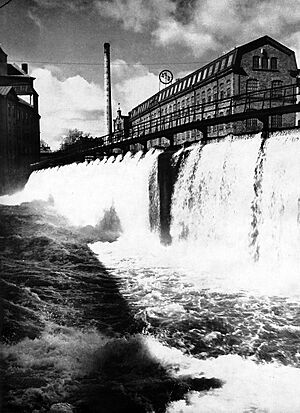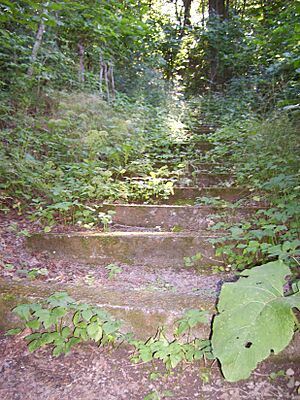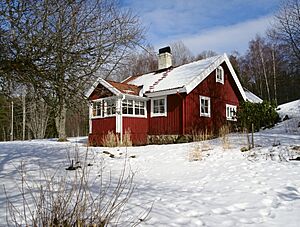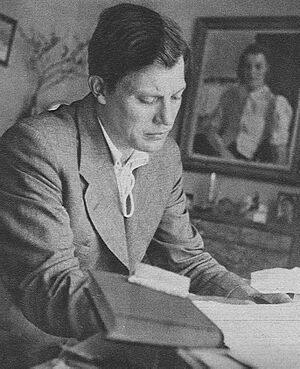Moa Martinson facts for kids
Quick facts for kids
Moa Martinson
|
|
|---|---|
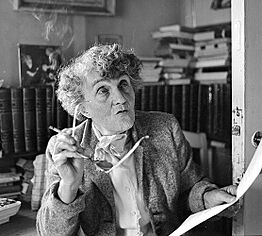
Moa Martinson in 1957
|
|
| Born | Helga Maria Swarts 2 November 1890 Vårdnäs, Sweden |
| Died | 5 August 1964 (aged 73) Sorunda, Sweden |
| Language | Swedish |
| Nationality | Swedish |
| Notable works | Women and apple trees My Mother Gets Married |
| Notable awards | The Nine Society's Grand Prize |
| Spouses |
|
Moa Martinson, born Helga Maria Swarts (sometimes spelled Swartz), was an important Swedish author. She lived from November 2, 1890, to August 5, 1964. Moa Martinson was known for writing stories about the lives of working-class people.
Her main goal was to help change society through her books. She wanted to show what life was like for people who worked hard, especially women. Her stories often explored themes like being a mother, love, poverty, and politics. She also wrote about how cities grew and the tough challenges faced by working women.
Contents
Moa Martinson's Early Life
Moa Martinson was born on November 2, 1890, in a place called Vårdnäs, in Sweden. Her mother, Kristina Swartz, worked as a maid wherever she could find jobs. Moa's father was not officially recorded, but he was likely a farmhand named Anders Teodor Andersson.
Because Moa was born outside of marriage, her mother went back to her parents' home for the birth. Moa's grandparents were poor and lived in a small, run-down cottage. Her mother tried to get child support from Andersson, but he never showed up in court. Eventually, her mother said he had gone to America.
Moa never knew who her father was, but this mystery inspired some of her writing. In her book Pigmamma (Maid Mother), she wrote about her mother's difficult situation. Later, in Mor gifter sig (My Mother Gets Married), she showed how much she disliked her absent father.
For her first few years, Moa lived with her grandparents while her mother worked. Her mother worked as a maid or in textile factories in Norrköping. These factories had very bad working conditions and low pay.
In 1892, Moa went to live with her mother. They moved many times to find work. Moa's mother married Alfred Karlsson in 1896. He worked odd jobs. They had three more daughters, but sadly, all of them died soon after being born.
Moving around a lot made it hard for Moa to stay in one school. But even with all the moves, she finished six years of school in 1903 with good grades. After she was confirmed in 1905, she got her first job on a farm.
In her book Kvinnor och äppleträd (Women and Apple Trees), Moa described the very tough lives she and her mother had in the 1890s. Some critics didn't like how she showed these harsh realities, but Moa said she was just telling the truth.
Becoming a Chef
When Moa was fifteen, she trained to become a pantry chef. This meant she prepared cold dishes like salads and desserts. She was the youngest person in Sweden to have this job at the time.
In the summer of 1906, she worked as a kitchen maid at a big restaurant in Norrköping. This restaurant was on top of a hill called Syltberget. To get there, you had to climb 80 steps. Moa wrote about her work and these stairs in her novel Kungens rosor (The King's Roses).
The book's name came from a conversation she had with King Oscar II of Sweden. They talked about flowers, and the King said he believed flowers had souls. Today, those 80 steps are still there and are called "Moa Martinson's Stairs."
In the middle of summer, she walks down the eighty steps. Counting them out loud one after the other, even though she knows very well their number. It is cloudy, almost dark, even though it is only July. The bright nights are waning. The scents of roses and honeysuckles waft around her. She stops, amazed by the quiet and beauty of the summer night. The noise from the day's busy time still stays in her ears.
In 1906, Moa moved to Stockholm hoping to find work, but it was difficult. During a time when the economy was bad (1907–1909), she had to move back to Norrköping. This period greatly influenced her interest in politics and workers' rights. She also tried writing poems, but they were not accepted for publication.
First Marriage
From 1908 to 1909, Moa worked as a pantry chef in different restaurants and hotels. In 1909, she met Karl Johansson in Ösmo. He was a stone worker and lived in a small cottage called Johannesdal in the woods.
Moa became pregnant in March 1909. Karl proposed, but Moa wasn't sure about marrying him. Still, she moved to Johannesdal with him. In her book Den osynlige älskaren (The Invisible Lover), she wrote about her first year as a mother and wife, the hard life at Johannesdal, and how much she wanted to leave.
Their first son, Olof, was born in 1910. Moa and Karl got married in 1922. They soon had more children: Tore in 1911, Erik in 1913, Manfred in 1914, and Knut in 1916. The birth of Knut was especially tough because she had to deliver him alone on the kitchen floor. Moa wrote about this in Kvinnor och äppelträd, and it's considered a very powerful description of childbirth in Swedish literature.
Life at Johannesdal was difficult and they were very poor. But Moa cared deeply about how her sons were raised. She did not believe in hitting children and disliked the strong nationalistic ideas taught in schools at that time.
Political Interests
Moa Martinson's interest in politics grew in 1921 when many people in Sweden were unemployed. In 1922, she and Karl joined a workers' organization called the Central Organisation of the Workers of Sweden. Moa became very active in it.
To learn more, she read books by famous authors like Fyodor Dostoyevsky and Émile Zola. Because she cared about better pay and conditions for workers, she was chosen to be on the local council in Sorunda. She represented the Labour Party. She left this position in 1926.
In November 1922, Moa wrote her first article for a workers' newspaper called Arbetaren (The Worker). She kept writing for the paper, and by 1923, she had articles published every week. She wrote about how men and women should work together to make the world better. She often joined debates, especially about women's issues.
Her work for Arbetaren helped her improve her writing. In 1924, she wrote that women and men should get equal pay for the same work. This caused arguments at the newspaper, and Moa left. But her articles in Arbetaren made her known to many people, especially in workers' groups.
A writer named Martin Andersen Nexø greatly influenced Moa. She felt like she finally saw her own experiences in a book. She wrote to him, telling him about her life and sending an article. He wrote back, encouraging her to write a book about her life. Soon after, Moa started writing Pigmamman (The Maid Mother). In 1925, she also worked for a new magazine called Vi kvinnor (We women), writing articles and stories.
Writing for Magazines
In April 1925, Moa's two youngest sons, Manfred and Knut, tragically drowned in a lake near their home. Moa was heartbroken and worked constantly to deal with her sadness.
After Vi Kvinnor magazine stopped in September 1925, Moa started writing for Arbetaren again. She also wrote for another paper called Brand and became part of political groups in Stockholm. Her first story, Pigmamma, was published in Brand in 1927.
She also wrote for other newspapers and magazines. In October 1927, she started writing for Tidevarvet (The Epoch), a magazine for women. She used a new pen name, Moa, so her friends in workers' groups wouldn't know she was writing for a more liberal magazine. She found the name "Moa" in a novel, where the character "Moa" was described as the first mother of humanity.
In November 1927, Moa traveled to Gothenburg. She hoped to get a job at a newspaper, but instead, the editor wanted her to work as a housemaid. Moa refused. While there, she met Harry Martinson for the first time. He was a writer who had been published in some of the same papers as her.
Karl's Death and Second Marriage
Soon after Moa returned home, her husband Karl became very ill. He started seeing things and couldn't eat or sleep. He refused to see a doctor. On January 14, 1928, Karl died. Moa had been thinking about divorcing him for a long time, as their marriage was not easy.
After Karl's death, Moa faced financial difficulties. Her friends in Stockholm raised money to help her. Losing two sons and her husband made her very sad. In March 1928, she took a typing course. When she left the school, she was known as "Moa."
During her time at the school, Harry Martinson wrote to her, asking if he could stay at her cottage in Johannesdal to work. He arrived in the summer of 1928.
Marriage to Harry Martinson
In the summer of 1928, Moa and Harry fell in love. However, Moa became more depressed and was hospitalized in March 1929. Harry stayed at Johannesdal, and they wrote letters to each other. They got married on October 3, 1929. Soon after, in May 1930, Harry was diagnosed with tuberculosis, which worried Moa greatly.
They had very little money. In 1932, Moa sent a draft of a book to a publisher. She worked on it for a year, and it was published in 1933 as Kvinnor och Äppleträd (Women and Apple Trees). This was Moa Martinson's first published book, and it received a lot of attention. At the same time, Harry was struggling with his mental health, which concerned Moa.
Harry was fourteen years younger than Moa, and their marriage was not easy. They also had very different writing styles. Moa was known for her direct, realistic writing, while Harry was more modern and refined.
Their financial situation improved in 1933. They rented an apartment hoping to fix their marriage problems. But Harry started leaving without explanation and would be gone for days. Harry's friends blamed Moa for his disappearances. Moa became very worried and jealous. She even hired a private detective, but it didn't help. Harry had started seeing another woman. In the summer of 1934, Harry admitted he had been seeing someone else, but said it was over. Moa was furious but forgave him.
However, Harry's affair continued. He would still leave Moa and Johannesdal from time to time.
Challenges and Divorce
On June 6, 1934, Harry suddenly left Moa and their home. He left behind a book manuscript. After ten days, Moa sent a message on the radio asking him to come home. This made Harry's departure public, and newspapers reported on it.
Moa and Harry stayed in touch through their publishers and friends. In August 1934, they were invited to a big writers' meeting in Moscow. Moa was fascinated by the communist society, but Harry was upset by the strong leadership of Stalin.
In the autumn of 1935, things seemed better between Moa and Harry. Moa was working on her book Mor gifter sig. In 1937, she decided to change publishers. She joined a publisher owned by the Swedish Social Democratic Party. She had disagreed with her previous publisher since 1934, and her choice was partly for political reasons. Her new book, a collection of poems called Motsols (Counterclockwise), was published by them.
During the 1930s, Moa suffered from severe stomach pains. Doctors couldn't find a cure. In June 1937, she was hospitalized. It was discovered that small metal pieces had gathered in her appendix. She had an operation. While she was in the hospital, she and Harry wrote letters. Harry's were loving, but Moa found it hard to trust him, and her letters were less warm. Their relationship was falling apart.
In 1939, Harry was hospitalized for a knee problem. After he was discharged, he went to Stockholm and stayed with friends. He stopped contacting Moa. After midsummer 1939, he filed for divorce and never returned to her or Johannesdal. They were legally separated in 1940 and divorced in 1941. Harry later married his second wife, Ingrid Lagercrantz.
A friend of theirs, Swedish writer Ivar Lo-Johansson, wrote about Moa and Harry's marriage in his book Tröskeln (The Threshold) (1982). Moa often asked Lo-Johansson to deliver messages to Harry when he was away and she didn't know where he was.
Later Life and Death
Over six years, Moa Martinson published eight books and earned the respect of most critics. When World War II started in September 1939, she saw it as a big threat to working people. She believed that non-socialist countries were sending workers to fight for things they didn't believe in. However, she felt that Russian workers were defending their revolution.
To earn more money and avoid loneliness, Moa tried writing for the film industry. She wrote a long movie script that a director became interested in. But Moa's ideas were too big, and when she asked for money upfront, the film company wasn't interested.
In the autumn of 1942, she met Karl Gunnarsson again. She had first met him in 1910. Gunnarsson was also a writer. Meeting him reminded Moa of her youth and moving to Johannesdal. These memories inspired her to write a love story called Den osynlige älskaren (The Invisible Lover).
During the 1940s, Moa Martinson became known in Sweden as "the Mother of the People." Her books reached many readers who could relate to the lives she described. She wrote many articles and stories for newspapers and magazines. She was also often asked to give lectures and traveled around the country. In 1944, she made her radio debut. Because of her strong personality, what she said and did got a lot of attention. She became a role model for many women in Sweden, especially working-class women.
In November 1954, Moa Martinson's mother, Kristina Swartz, died at 83. Their relationship was very strong, and her mother was a big influence on Moa's writing. In My Mother Gets Married, Moa described her mother as her best and most trusted friend.
As Moa's health got worse in the 1960s, she stopped writing. Even though her reputation as a writer had gone down over the years, she still meant a lot to working-class women. Despite her declining health, she still enjoyed debating and always expressed her feelings.
Moa Martinson died on August 5, 1964, at the age of 73, in Sorunda. She is buried at Sorunda Church.
Moa Martinson's Legacy
In the 1970s, Moa Martinson became a role model for female writers during the feminist movement in the Nordic countries.
It's strange, but I'm mostly upset not because I couldn't go to university, but because I ended up in the same difficult situation as my mother. Maybe it was even harder for me, because I fully knew how bad it was. I understood the unfairness against all of us, and I felt helpless.
In 1989, a special literary award was created in Moa Martinson's name. It's called the Moa Award (Moa-priset). This prize is given every year to a writer whose work reflects Moa Martinson's spirit.
Awards
- The Nine Society's Grand Prize, 1944
Adaptations
Films
- (1974) Rågvakt, a TV movie based on her novel, directed by Göran Bohman, starring Christina Evers.
- (1986) Moa, a movie about her life, directed by Anders Wahlgren, with Gunilla Nyroos playing Moa.
Television series
- (1979) Mor gifter sig, a TV series based on her novel, directed by Per Sjöstrand and starring Gurie Nordwall, Hans Wigren and Nina Ullerstam.
|


